Valentin Vasilescu demonstrates here the impossibility of the theory of a bomb placed in the plane. After having explored all hypotheses, there is now only one left – that of a failure in the software of the automatic pilot. We may therefore conclude that the accusations of the United Kingdom and the United States, as well as the claim for responsibility by the Islamic Emirate, are propaganda. The crash was not a terrorist attack. But the problems in the automatic pilot system may be either an accident or the effect of sabotage by an extremely specialised secret service.

Russian investigators brought with them to Egypt a complex apparatus designed to test the débris both inside and outside the plane. This equipment enables the detection of aerosol-based explosives to a level of sensitivity of 20 nanogrammes. If, in the test solutions, there appear traces of a brown-violet colour, the agent is revealed as TNT. If an orange precipitate appears, the explosive is Tetryl, or another explosive from group A (TNB, DNT, picric acid, etc.). The Russian device possesses a range of separate tests for explosives from group B. With this system, the appearance in test solutions of a rosy colour would indicate the use of dynamite, nitroglycerine, RDX, PETN, SEMTEX or nitrocellulose. If the chemical reactions do not identify explosives from groups A and B, the test equipment automatically checks for the presence of components containing inorganic nitrates, such as chlorine, bromine or peroxyde, used in the preparation of improvised explosive devices (ANFO).
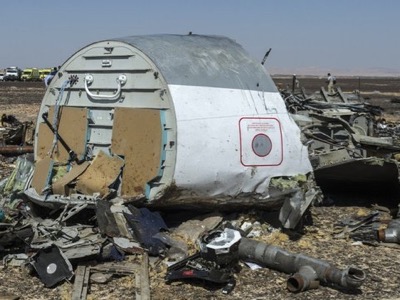
The Egyptian daily Almasry Alyoum published a declaration from the team of investigators working on the accident of the Russian A321 in the Sinaï peninsula —the team affirmed that no trace of explosive had been discovered in the débris of the plane, or on the articles of clothing and tissues recovered from the passengers. Thus, the hypothesis conveyed by British civil servants - according to which the crash of the Russian plane had been caused by an on-board bomb, on the basis of the so-called ’interception’ of a conversation between leaders of the Islamic Emirate – is proved to be false. The hypothesis of an attack by a missile, either ground-to-air or air-to-air, also collapses, since missile war-heads contain TNT, a substance which was not detected by the investigators. The hypothesis of an explosion in one of the motors must also be discarded, since the turbine blades were discovered to be intact.
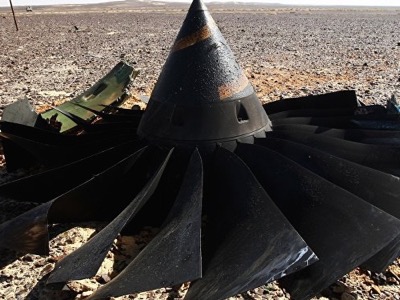
The same is true for the theory of the explosion of one of the fuel tanks, since these are situated in the wings, and an explosion to the right or left would have detached the wing from the fuselage. But the wings fell to the ground intact, a few metres away from the anterior part of the fuselage, before catching fire. This fact indicates that they were not detached from the fuselage, and that there was no fire in the fuel tanks before contact with the ground.
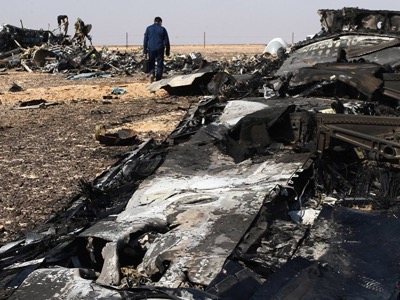
Thus, the myth woven by the US television channel NBC, according to which the Pentagon declared that a US military satellite had detected, in the area and at the moment of the accident, a peak of heat and light, turns out to be a lie. Finally, at this point, the Islamic Emirate or any other terrorist organisation, is relieved of responsibility in the crash of the Russian Airbus A321 in the Sinaï,which, apparently, bothers the US and UK governments. Why?
Depressurisation in the plane remains one of the active hypotheses, but only as a result of the plane’s chaotic manœuvres, and not as a cause in itself. As I pointed out in a previous article [1], the repetitive pitching movements, with negative and positive overloads beyond anything normal for a passenger plane, are what led to the separation of the exterior panels, the twisting and dislocation of certain resistance elements in the plane’s basic structure (central girders, ribs, etc.) and rupture of the hydraulic pipes and hoses fixed to the exterior cladding. In the absence of hydraulic pressure, the plane’s crew can control neither depth nor direction. The abnormal noise, discovered during the analysis of the black box, probably indicates depressurisation, followed by the dislocation of some of the plane’s parts at an altitude of about 5,000 to 6,000 metres, as confirmed by the impact of large fragments of the plane over more than 2 kilometres in the direction of the flight.
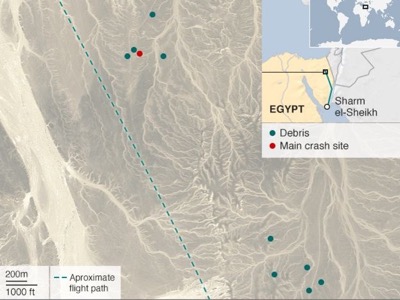
Let’s return to 06:12:59 in the progress of the accident, and attempt to decode each of the fluctuations in the flight parametres. It is essentiel to underline the fact that the plane was at that moment flying by automatic pilot. First of all, we note a 3-second descent, with a loss of altitude of 150 metres, which led to a negative overload of 2 G. This manœuvre is too sudden, producing an « air-pocket » sensation, to have been commanded by the flight crew.
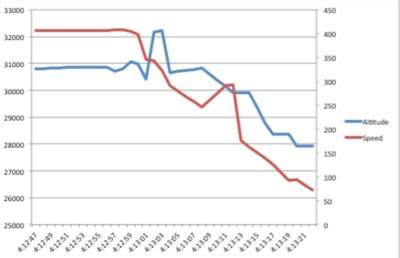
The second command was the aircraft’s recovery, climbing 800 metres in 2 - 3 seconds, causing positive overloads of between 5 and 6 G, values which only exist for fighter aircraft in close combat situations, and lead to the pilot’s loss of vision, known in aeronautical jargon as the « black veil » . In my opinion, it is impossible that this command could have been originated by the flight crew – only a defective automatic pilot could have generated such a climb. If the pilots had been at the controls, after the first brutal descent, they would have redressed the plane progressively, first of all horizontally for 8 to 10 seconds, then climbing slowly to return to their cruising altitude.
The third command consisted of switching from a 40° to 50° climb to a dive of 20° to 30°, with a negative overload of 4 G, and it is impossible for this manœuvre to have been executed by the crew of a passenger aeroplane, because everybody loses consciousness, with the appearance of what is called the « red veil ». The only moments in which the crew could apparently have intervened would have been during the brief moments of horizontal flight – 5 seconds and 3 seconds, if unhindered by further uncontrolled developments. In normal situations, the aerodynamic centre of the automatic pilot will not allow manœuvres which could lead to overloads close to material destruction, whatever commands may be operated by the pilot in manual control. The cause of these chaotic manœuvres can therefore only be due to a dysfunction of the mechanism of the automatic pilot.
Apart from the failure of the automatic pilot’s computer, due to material exhaustion, I have explained, in a previous article, that it is possible to take control of the A321 from the outside, by hacking into the automatic pilot’s software, either through a previously-installed programme, or via a ground-based transmission. By a strange « coincidence », from the first seconds that the plane’s chaotic manœuvres were noted, both the transponder and the radio ceased transmitting. The transponder would have indicated the plane’s flight parametres to the air traffic controllers and, via the on-board radio, the crew could have signalled the appearance of an emergency situation and described the plane’s behaviour.
However, what led to the dysfunction of the automatic pilot at that precise moment, only the investigating committee will be able to determine.
[1] « Les causes possibles de l’accident de l’Airbus russe dans le Sinaï », par Valentin Vasilescu, Traduction Avic, Réseau Voltaire, 10 novembre 2015.

 Articles by this author
Articles by this author Send a message
Send a message





















Stay In Touch
Follow us on social networks
Subscribe to weekly newsletter